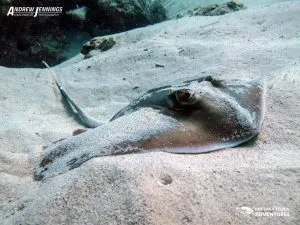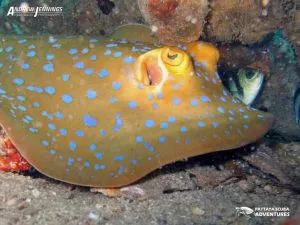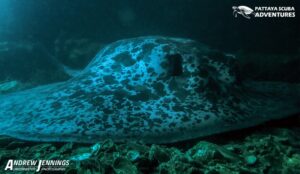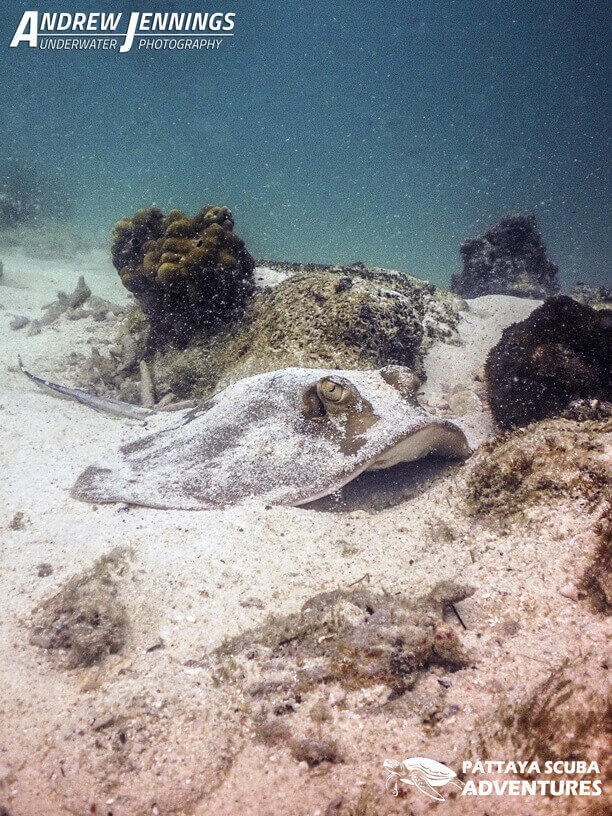Stingrays of Pattaya Thailand
Did you know there are about 51 recorded species of rays in the Gulf of Thailand? There are about 11 types of stingrays that we see here whilst diving in Thailand around Pattaya and Samaesan.
Most live on or in close proximity to shallow coral reef, whereas others are what we call a pelagic species ( pelagic named after the zone in waters that is neither close to the bottom nor near the shore) are usually be found in deeper waters and dive site such as pinnacles or wrecks dives or on deep drift dives. Commonly when diving in Thailand, especially around the Pattaya and Samaesan dive sites we usually encounter some kind of stingray on every dive, the question is which one will you find!
Types of local Pattaya Stingrays
Know Your Gray Rays: Common Gray Stingrays
Common sand rays or gray stingrays are often misidentified because they look so similar. These rays found in Thai waters usually fall under one of the following species:
Short Tail Stingray Vs Smalleye Stingray
Now the Short Tail ray and the Small-eyed ray are very alike. But once you know that the small-eyed stingray has a more pronounced diamond shape with a fatter tail you can easily tell the difference.
Whip Stingray, Sharpnose Stingray
The next gray stingrays often confused for each other, are the whip rays vs the sharp nose rays. This confusion and misidentification surround the pointed nose area of these two particular local stingrays. Eventually, once you have seen both rays it’s clear to see that the sharpnose ray has a much narrower and pointed nose than the other as well as a slightly lighter color overall.
Blue Spotted Rays
The blue-spotted Ribbontail rays (Taeniura lymma) are found everywhere around our local dive sites and are not to be confused with The blue-spotted stingray (Neotrygon kuhlii), also known as Kuhl’s stingray which kind of looks like a small eyed ray but with blue spots. Blue-spotted ribbon tail rays are stunning yellow skin with vibrant electric blue spots, a real flashy dresser who if you are slow and relaxed will have no problems posing for some awesome underwater photos
Marble Ray
The Blotched fantail ray (Taeniura Meyeni muller and henle 1841 )Also known as a marble ray, black-spotted stingray or giant reef ray, this round ray can reach lengths of up to 10 feet (3 m). They have a distinctive white-and-dark mottled pattern, and they’re quite common in tropical Indo-Pacific waters. It is normally whilst wreck diving that we discover these larger rays. Laying on the sands at the side of HTMS Khram for example or under the stern area of The Bremen Wreck. The largest we ever saw was a good few years back inside the forward hull of the Hardeep Wreck and there were 3 together. 2 of which on any other day we would have said were big rays but by comparison to the big momma who was with them, they looked like babies. Big Momma Ray was for sure close to fully grown and easy 3m long. This family of rays is reported as visited this wreck quite a few times during the peak dive season.
Large Bull Ray / Smooth Short Tail Ray
Around a certain time in the year, we are graced with Dasyatis brevicaudata or Giant Bull Ray or Giant Smooth Stingrays. These are some of the big boy rays we encounter here while diving in Pattaya. Usually found in deeper water by the wreck dive site or on steeper banks or edges of deep reefs. They have many names and are enormous rays growing up to 4.3m in length, 2m in width, and weighing up to 350kg. They feed mainly on fish, crustaceans, and mollusks which they catch on the seafloor, often by digging in the sediment like other stingrays.
The Smooth Stingray has a very large serrated spine on its tail which it uses for defense, curling its tail overhead like a scorpion when feeling threatened. Although not normally aggressive, due to their large size, they can be very dangerous and should not be approached when they are exhibiting this behavior. It is believed that it was a type of large Bull Ray that was responsible for the death of naturalist Steve Irwin on the Great Barrier Reef in 2006.
Devil Ray or Mabula Ray or Manta Ray?
Other Stingrays often confused for each other are Mabula and Manta Rays both often referred to as devil rays. These are pelagic larger rays, so if you want to see them you are best to join a deep drift to have a chance to encounter the Mobula ray around Pattaya and Samae San waters. These rays come from the family Myliobatidae (eagle rays). Their appearance is similar to that of manta rays, which are in the same family. Often referred to as “flying mobula” or simply “flying rays”, because they swim up and breach the surface soaring into the skies before returning with a splash. We have seen them do this here close by the Pattaya Near Island of Koh Khrok and far out near Hin Chalarm in Samaesan San. But you’ve got to get lucky to win tickets to this show!
Are Stingrays Sharks?
Sharks and Stingrays are very closely related. Both are part of a group of fishes called the elasmobranchs. All elasmobranchs have 1) skeletons made of cartilage (the flexible material that makes up the tip of our nose and ears) and 2) 5-7 gill slits. Elasmobrachs include sharks, rays, and skates. You wouldn’t be far wrong to think of stingrays as flattened sharks. On the inside, they’re just about the same. Some animals blur the lines between the two. Angel sharks and wobbegongs are flat, but they’re not rays. Then there are sawfish (which are rays) and saw sharks (which are sharks). Shark rays are just plain confused. As a general rule, if the gill slits are on the bottom, it’s a ray. If they’re on the side, it’s a shark.
Are Stingrays Dangerous?
Stingrays are not known to just up and attack and by and large are completely harmless to humans. They would only attack in self-defense which would be triggered by divers interfering or even snorkelers could perhaps step on them. This is why rays are always listed on the Dangerous Aquatic Animal Chart you see on dive boats but just follow the normal dive rules and look and don’t touch and you’ll be just fine!
The Behaviour of Stingrays
Ok, let us start with our most common ray, the blue-spotted ribbon tail ray, blue-spotted rays’ behavior differs from other stingrays in that it doesn’t like to be covered in sand as other species do. Instead, it prefers to parade its beautiful blue spots and, to stay up to the best standards. To achieve its grooming, it needs the help of cleaner fish. These cleaner fish remove parasites from larger fish. Their coloring gives them a sort of uniform, which lets the larger fish know not to eat them. Most other fish cannot approach rays in general undetected without concern. Fish transmit electrical signals that a ray can detect with a skill called electroreception. Stingrays locate prey and gobble it up easily using their snout. The ray can then crush the prey using the plates within its mouth.
Now, Pelagic ray species are known to stay farther from shore leaving their bottom feeder brother to feast close to the shore on mollusks, crustaceans, and occasionally on small fish. Pelagic stingrays dine gracefully and in style. Swimming using their pectoral fins they look like a giant bird flying in the sky and While these Rays have many rows of sharp teeth, they aren’t used for eating. Instead, they have a filtering system to trap and move food to its mouth.


















